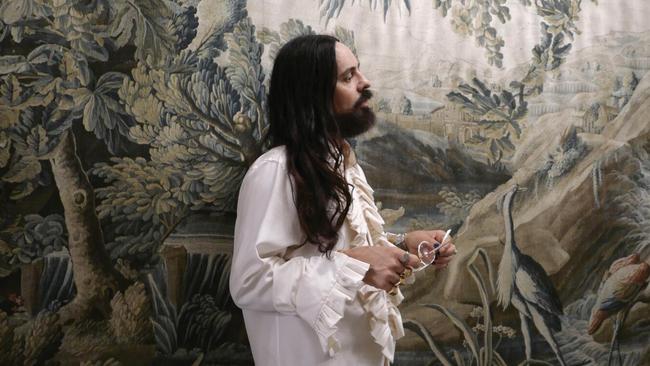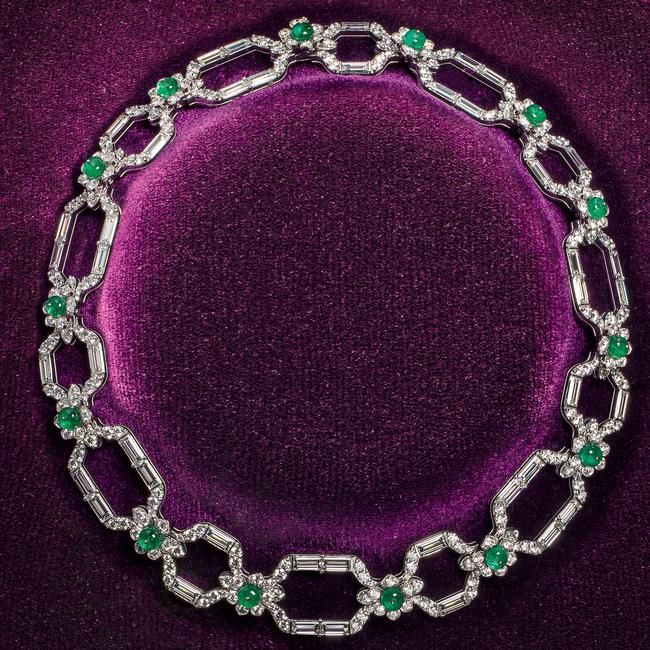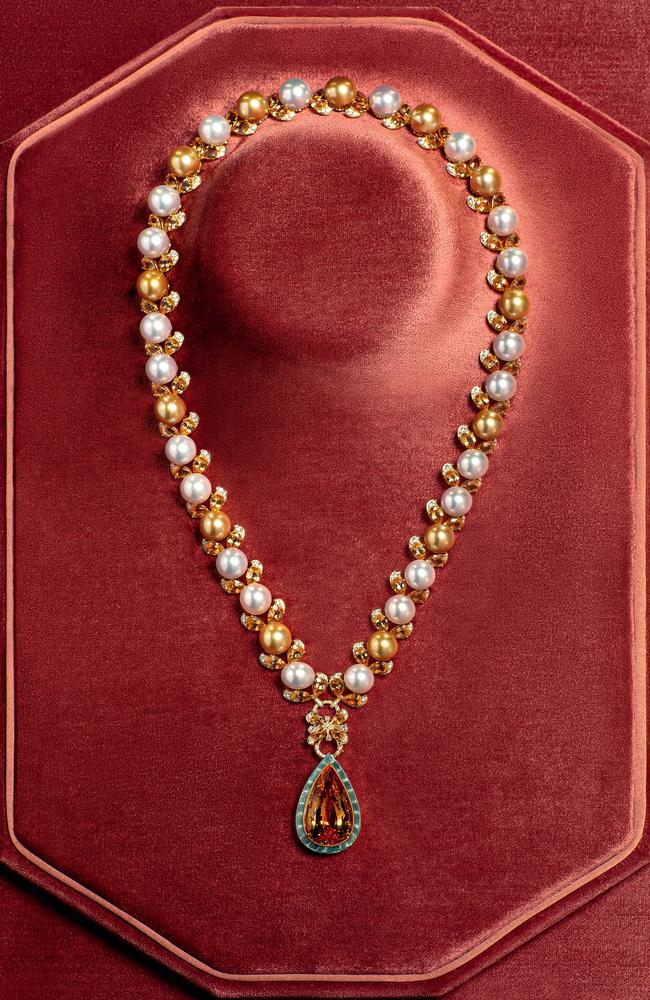Alessandro Michele’s latest Gucci high jewellery reveal
Name a more auspicious locale for Gucci creative director Alessandro Michele, the man who has defined fashion’s present, to showcase his new high jewellery than a Roman villa steeped in art history.

Behind a tall but relatively unostentatious iron gate in Rome, down an enticing avenue lined with neatly clipped box hedges and around a circular parterre, an opening in the green verge appears. Pass through it, and a sprawling formal garden in rococo furls, the size of a football field reveals itself to the sound of birdsong and the soft gurgle of a water fountain. Sentinel over this really rather surreal idyll, windows thrown open in the baking summer heat, is the Villa Albani Torlonia. A little-seen Roman jewel, owing to a penchant for privacy by the owners, it was built to house a staggering collection of Greek and Roman antiquities – collected by a nephew of a pope no less – Cardinal Alessandro Albani.
The fact that it is lesser known (some Romans profess they don’t know what is behind its walls) belies its historical and cultural significance. To art historians it is the cradle of the Neoclassical movement. One fresco, Il Parnaso, by Anton Raphael Mengs, is considered the first ever truly neoclassical work and helped situate Rome at the apogee of the Grand Tour, that mythic quest for cultural enlightenment undertaken by scholars and artists around Europe in the 17th to 19th centuries. The villa’s 600-plus pieces have been sought after by the Louvre, and today, still, the Italian government for public display.
Name a more auspicious locale for Gucci creative director Alessandro Michele to showcase his new high jewellery collection. The third ever for the Italian house, the latest instalment of Hortus Deliciarum, or Garden of Delights, is sitting under said fresco, the glittering creations ensconced at a juncture of histories – from the antiquated, to the Victorian and contemporary.
It’s a temporal collision that, with collector’s tendencies himself and a feeling for the past that rivals any historian, mustn’t have escaped the Roman-born Michele. In fact, the collection of 200 pieces is engineered as a kind of timetraversing journey. Broken into five chapters, it spans eras and continents in inspiration and provenance. Brilliant Mexican fire opals stud an ornate necklace replete with a micromosaic centrepiece; juicy red rubellites sit alongside heart-shaped blue tanzanite – both gemstones from the African continent – on a multistrand necklace; and Australian pearls alternate with golden Indonesian ones the size of marbles in an elegant Victorian-style sautoir with pear-cut topaz, drawing on ancient Rome, the courts of the Maharajas, and Botticelli’s Birth of Venus, respectively.

“I like history because it’s like a vault. You can pick up things and put them in the present,” says Michele, speaking ahead of a gala dinner later at the villa for VIP guests. The man who was promoted from unknown design assistant to creative director of Gucci in 2015 has an intense affinity with bygone worlds, such that it informs every one of his creative outputs – from men’s and women’s ready-to-wear, to stores, to homewares, and recently high jewellery, all of which he oversees. In fact, it was this innate interest that alerted then new CEO Marco Bizzarri to Michele’s talents, appointing him in the top design job after a conversation between them about Gucci’s history and how that could shape its future.
Seven years later, his disregard for the boundaries separating past and present have underpinned his total revitalisation of the house. When he assumed the role, Michele had been at Gucci since 2002, working part of this on accessories for then creative director Frida Giannini, before she was let go as the house faded in the afterglow of Tom Ford’s halcyon years. In the period from 2015-19, Gucci’s profits have roughly quadrupled. Though the pandemic dealt a heavy blow, in 2021 revenue sat at €9.7 billion (AU$14.3 billion), just above its €9.6 billion (AU$14.1 billion) in 2019.
Though recovery hasn’t been as rapid as perhaps desired, parent company Kering, at which Gucci is the star-earner, has a clear growth plan. It’s looking to gradually raise prices and renew focus on ultra-luxurious categories of leather goods, aiming to grow the house to a €15 billion (AU$22 billion) brand in the next roughly three years. As of 2019, high jewellery is part of this, a category increasingly seen as a growth opportunity by fashion houses without a jewellery only pedigree in the space, from Hermès to Chanel and more recently Fendi. Jewellery has been outperforming other segments of the luxury market – with the diamond jewellery segment growing 29 per cent in 2021. Michele’s task has been how to translate his unique brand of dressing – plucking influences from the vast kaleidoscope of the past in a joyously eccentric, maximalist intermingling – into precious gems and metals.
Thus far his nostalgic approach, subversive in an industry obsessively preoccupied with newness, is drawing clientele; many creations already have discreet stickers on their plinths, indicating they’re sold. A self-professed jewellery obsessive (and collector), today a cameo bracelet adorns one wrist, heavy rings his fingers, while two delicate drop earrings swing lightly from his ears. In a striped cotton shirt, long dark hair plaited into two pigtails, he occasionally wields a black fan in the June heat.
“I like history because it’s like a vault. You can pick up things and put them in the present”
“I was starting the research of that kind of micromosaic to try to do something very experimental – to put an old piece from old jewellery on something new that is completely reinvented,” he says in his melodious Italian inflection. “How could it be beautiful to do an amazing frame of diamonds and colourful stones around that kind of piece of art from the past? I have to say that the result is something really unbelievable.”
The buyer will receive a true one off. Framed by precious stones, the mosaics are in fact antiques dating to the 1850s and 1870s, chosen by Michele. Each is a miniature picture, in tiny tessellating pieces of glass created with a technique called tesserae, often bought on the Grand Tour as a precious souvenir; a snapshot travellers could bring home. One necklace features a 19th-century mosaic of a view of the Temple of Hercules at Cori, festooned with a diamond bow, and a shimmering fringe of tiny diamonds in moving pavé strands. Michele’s special brand of anachronistic alchemy could only have got off the ground with fearlessness – a trait thrown into relief most in the rarefied world of high jewellery.
Ruled by a few key players with histories far outdating Gucci’s, there could be a temptation to kowtow to unwritten rules, arcane traditions; which stones go together, how cuts should be paired, time-honoured techniques to deploy where. “I don’t care about where they came from, what’s the cut, what’s the colour,” he says slightly roguishly. “I love to be pornographic in the way that I put the stones together … With different kinds of crazy colour combinations, it’s like they are screaming sometimes altogether. I love to create this kind of crazy conversation.”
This can go a long way to explaining the appeal of Michele’s vision. Once made to feel an outlier at school for dressing differently, and since rocketed to the centre of fashion, Michele has throughout maintained a consciousness of how fashion can feel like a closed world. His cadre of brand friends, who are now also personal friends, from Jared Leto, who he accompanied to the Met this year, and Harry Styles who has challenged notions of masculinity with his gender-fluid wardrobe, and who in June released a Gucci collection (named ‘HA HA HA’ – their first initials), have a misfit quality that speaks of his inclusive vision.
“I’m going to imagine this brand as a platform, as a stage of the things that’s going to inspire other people. I imagine this brand as a hug”
When Michele launched his first beauty campaign, with make-up direction by Australian Thomas de Kluyver, it featured gap-tooth punk singer Dani Miller, who afterwards had people DM her on Instagram saying they no longer wanted their teeth fixed. Recently, Gucci were among the first to embrace the gaming world, largely ignored by fashion, launching Gucci Gaming Academy, equipping young esports gamers with contract-signing knowledge and mental health support. Moves like this appeal to those with whom fashion’s carefully curated ideas of perfection don’t chime. But how does that extend to jewels with six-figure price tags and upward?
“It seems like a crocodile bag or a high jewellery piece, they are not really opening the door to everybody. But it’s like that you are saying, ‘I don’t own a piece of art.’ You can buy a Vincent van Gogh piece that you can put on the wall in your house that could be also in the museum,” he theorises, positing that you don’t need to own something personally to feel something. “I think that the beautiful thing about beautiful pieces – you can enjoy them and be inspired, [without] getting in touch,” he says. “I don’t care who’s going to buy it – I just care that they’re in touch with that beauty. That’s what I try to put in the shows. That’s what I’m putting almost everywhere.”
It could be easy to be cynical about such notions, but Michele’s emotion, his genuine enthusiasm for things of beauty is palpable when he speaks. One of the stones for this collection, a 172.4-carat emerald with unusual inclusions cut in a hexagonal slice, captivated him. He recounts his team calling him as it was going to auction.
“I was at home, I think I was eating at dinner time, and I was like, ‘Let’s try to buy.’” They did. “When I saw the stone, I was really dying.”
Jewellery, too, is close to him personally, and it’s been getting increasing airtime in his ready-to-wear collections. Layered into his clothes, they were most recently in evidence at the resort ’23 show held at Castel Del Monte in Puglia: a sautoir over an elegantly monastic black dress, like a religious talisman, and a curlicued diamond-encrusted cuff over a white opera glove. The ornateness of his high jewellery has an obvious synergy with his own taste, his decorative, ‘fake vintage’ as he’s deemed it.
“I spend all of my free time looking at jewels,” he says. “It’s like you are working on something that is so close to your sensibility.”

Ideas come quickly to him, but he is enthralled by the longer time frames attached to producing jewellery, by Gucci’s dedicated artisans in the Valenza region – a storied jewellery-making region. “You’re going to wait a long time just to see a little detail. They’re going to take 15 days because they’re going to work on that detail day and night.” He keeps videos on his phone of the process. “Sometimes when I’m alone, I go through the video – like when you did a video of a rock show and you have your best singer singing in front of you. You’re going to be again at home, looking at the video.”
In Rome, rooted by the past and surrounded by it, he can speak of lofty ideas knowing he will always be anchored by history. Having grown up there and then studied at Accademia Costume e Moda, it has taught him a unique way to deal with it – reverentially, but still light-handed, instinctual.
“History doesn’t belong to an imagination story. It’s not about a fairytale – ‘Once upon a time’ – no. It’s in front of me, in front of the bus station. That’s the present. When you see the Colosseum, it’s here,” he says. “I learned to be affected by the past that became the present. Because all of us, I mean, we are dealing with the past every day, in every single city – not just in Rome. Rome, maybe, is a strange laboratory where you can see 1,000 years that are in front of your eyes every day. So I learned like an animal, to know my environment and I use the environment in the way that I need.”
The great collectors, enthralled of the past and its preservation, gave their collections most life when they allowed others to see it. From the Medicis, to the great collections of Napoleon Bonaparte, and Cardinale Alessandro Albani – the prizes from their travels and travails gave rise to a vitality and sometimes, new art movements when others came to see it and ideas were sparked. Fashion’s great collector, Alessandro Michele wants people to experience his creations as part of their lives and expression, and if they can’t do that, he at least wants to touch people with things of beauty.
“I’m going to imagine this brand as a platform, as a stage of the things that’s going to inspire other people. I imagine this brand as a hug.”
One thing is certain – his creations are intended to be seen. “[If] you are selling in a very private way, nobody is going to see. Nobody is going to know. Maybe it’s beautiful, but it’s less because we are not sharing. I’m trying to share everything.”
This article appears in the September issue of Vogue Australia.

To join the conversation, please log in. Don't have an account? Register
Join the conversation, you are commenting as Logout